|

by Philip Coppens
This article originally appeared in
Frontier Magazine 5.4
(July-August 1999)
from
PhilipCoppens Website
|
A small
island in the middle of the Mediterranean Sea contains
some of the biggest megalithic monuments. They form a
major scientific enigma, which science has difficulty to
explain. Perhaps it is because certain basic, but
nevertheless key, observations have been bypassed…
|
The three small islands of Malta,
Gozo
and Comino float in the middle of the Mediterranean Sea, south of
Sicily and east of the Tunesian coastline. Though small, their
history dates back thousands of years – and continues to throw a
magical spell on many visitors. And we need to ask whether the
modern tourists are the last in a series of sun worshippers that
came to these islands.
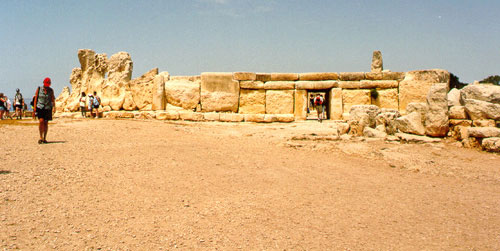
Various megalithic monuments are located
on Malta, dated at approx. 4000 BC. What is important is that the
buildings are unique in style and that their builders – as is so
often the case – are unknown.
Malta is by far the biggest of the three islands: it measures 40 km
in length and is 20 km wide. The eastern part of the island has the
megalithic monuments of Tarxien, Hagar Qim and Mnajdra. The most
northern is Tarxien, a vast temple complex that has become
surrounded by a modern town. Next to the old temple rises a modern
church, as if underlining that what was once sacred, still is. The
megalithic “church” consists out of a series of oval-shaped
“chapels” – typical for the Maltese temple structure.
The temple of Tarxien is unique as it holds its own spring.
Archaeological finds in the form of vessels suggest that water must
have played an important role on this site – and it is more likely
that the role of the spring and its water was spiritual, rather than
economic.
Better known is the subterranean chamber complex nearby: the famous
Hypogeum, dating from the 4th and 3rd millennium BC. It is here that
the remains of no less than 7000 people were discovered.
Archaeologists believe that both Mnajdra and the Hypogeum should be
considered as one whole, but as the purpose they served, that
remains an open question. Was the Hypogeum a temple of the dead, a
cemetery? Certain finds inside do suggest that rituals were held
inside the complex.
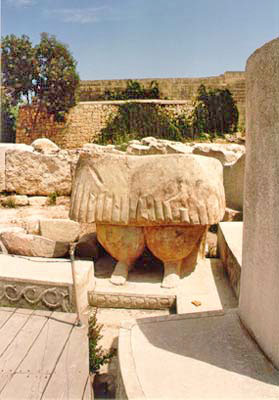 The
sites are located in the middle of a modern town, which makes it
difficult to imagine the temples in a more original setting. But
that setting can be perceived in the southern parts of Malta. The
sites are located in the middle of a modern town, which makes it
difficult to imagine the temples in a more original setting. But
that setting can be perceived in the southern parts of Malta.
On a slope near the coastline are the temples of Hagar Qim and
Mnajdra. Both temples are close to each, a few hundred meters apart.
Again, it suggests that both temples were part of one complex. When
the complex is approached from the direction of Tarxien, the visitor
finds himself in a valley that leads to the sea. It is there that
the famous “Blue Grotto” can be found, an impressive display of
nature that for modern tourists is still considered to be a “must
see”. It is perhaps this natural wonder that might explain the
presence nearby of the temple complex, as it is located at a mere
few hundred meters.
Hagar Qim is the most impressive of all Maltese monuments. The
finesse that was used to join the stones can be compared with the
precision employed in the Valley Temple, next to the Sphinx, at
Gizeh (Egypt), where the builders equally carved out massive stones
and placed them together as if it was the easiest job in the world.
But it is only the massive size of the stones that allows for such a
comparison. Other than that, both sites have their own unique design
and decoration. Still, as we know, that the Hagar Qim monument
predates the Valley Temple with many centuries… could this Maltese
knowledge of working with giant stones have made it into Egypt?
The small island of Gozo also has a megalithic temple: Ggantija. The
name is derived from local folklore, which says that only giants (gigantes)
would have been able to construct such a complex. Its folklore is
just a modern remain of the legendary importance the Greeks had
instilled on the island.
In Greek mythology, Gozo was the island where the nymph Calypso held
Odysseus imprisoned for no less than 7 years. Her cave is situated
near the temple, with the cave offering one of the most stunning
view of the most famous sandy beach of the island. If Odysseus was
indeed imprisoned here, the view from his prison window was
excellent.
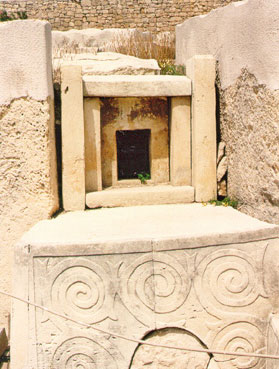 The
temple of Ggantija contains – according to UNESCO – the largest free
standing stone in the world. In itself, this is not that impressive,
as there are larger stones elsewhere – they are just not free
standing. Nevertheless, Ggantija is yet another impressive temple.
What is very intriguing is that north of the temple itself, a stone
circle can be found – showing that “classic megalithic monuments”
were also constructed on the island. It is here that archaeologist,
in 1987, uncovered human skeletons. The Xaghra stone circle
furthermore has a subterranean complex of natural caves, which seem
to have been used as a cemetery – thus apparently identifying this
location as a Gozo counterpart of the Hypogeum on Malta’s mainland. The
temple of Ggantija contains – according to UNESCO – the largest free
standing stone in the world. In itself, this is not that impressive,
as there are larger stones elsewhere – they are just not free
standing. Nevertheless, Ggantija is yet another impressive temple.
What is very intriguing is that north of the temple itself, a stone
circle can be found – showing that “classic megalithic monuments”
were also constructed on the island. It is here that archaeologist,
in 1987, uncovered human skeletons. The Xaghra stone circle
furthermore has a subterranean complex of natural caves, which seem
to have been used as a cemetery – thus apparently identifying this
location as a Gozo counterpart of the Hypogeum on Malta’s mainland.
The presence of a temple connected with a subterranean cemetery
seems to hint at rituals to do with the dead. Perhaps the temples –
as was popular elsewhere – might also have been used by priests,
employed to contact the ancestors. As there are no written
traditions, at present, it is important to be more prudent and thus
conclude that perhaps the temples and underground complexes were
merely used for funerary rituals.
The megalithic monuments no longer have a roof, but drawings that
date from previous centuries and small models that were left by the
megalithic builders themselves reveal that the temples once were
roofed. If the roof was made from stone, then it is a major enigma
where they disappeared to. Perhaps it is more like that other
material was therefore used. Still, some archaeologists have
concluded that stone would have been the preferred material for the
roof – as such a roof would have been virtually impossible to build,
they have concluded the temples never had a roof. Still, if we
assume that the temples did have a roof – made of stone – than these
structures would have closely resembled caves: artificial caves,
made to resemble the natural caves?
Many temples are decorated with spirals, and the temples have oval
shaped chapels. Certain temples have three ovals, though most have
seven. Most temples also contained statues, though most have been
partially destroyed – either by the passing of time, or by a
deliberate act of destruction at some point in the past. Some of the
statues seem to be of a giant woman, with giant breasts, thighs and
arms. Were they statues of the Mother Goddess? Many archaeologists
believe this is indeed the case, though certainty should not be
confused with belief in such cases.
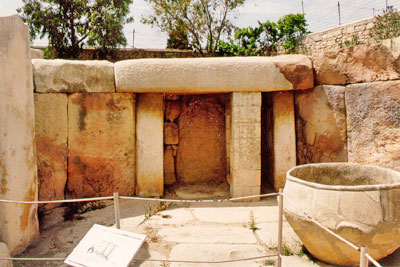
Though many archaeological discoveries
have occurred in the last century, certain questions remain open:
who were the people that build these temples? Where did they come
from?
Apart from the temple, there are also the enigmatic “cart ruts”,
which can be found in certain sections of the island. What purpose
they served is unknown, but some speculate that they may have been
markings in the rocky surface which would allow cows or bulls to
follow the grooves, “guided” as it were by a mechanism that
connected them to the ruts. This theory has become a hot topic of
debate, even though near one car rut, a wheel, made from lava stone,
was discovered. Perhaps they had an astronomical purpose, but if so,
it is highly improbable that this can ever be proven. At present,
the most likely possibility is that they will remain a mystery…
though a major discovery seems to be made approximately every
decade, so one will never know…
Malta is an island; the closest land – Sicily – is invisible from
its shores. Was Malta on par with Crete, as a site of a very ancient
culture? There are certain parallels between the two islands. First
of all, though both islands have their unique style, the general
layout is largely identical: the presence of temples is in the
eastern second of the island, close to the sea, and mostly in the
northern and southern part (of that eastern section). They are –
furthermore – temples: buildings. At the same time, they are
separated by 2000 years. But as on Crete, it is clear that there is
an interrelationship with caves and temple complexes – though the
caves of Malta could never be found at the altitudes that some of
the Cretan mountains rise to. Finally, some of the artifacts
recovered from the sites are identical to artifacts recovered at
e.g. Knossos, specifically the vessel.
Though such comparisons can be made, it does not explain why Malta
was chosen, and not Sicily. Certain demographic conditions might
have already existed so many millennia ago that did not allow these
people to build there – but perhaps there is a reason why Malta was
specifically chosen.
Malta has a unique climate: an incredible amount of sunshine, a
statistic it shares with e.g. Carnac in France, where other major
monuments are found. Furthermore, the Carnac structures were
constructed at roughly the same time as the monuments of Malta. Were
the people of Malta solar worshippers?
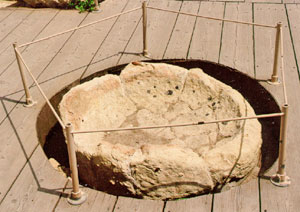 The
possibility that the religion of the Maltese temple builders was sun
worship seems likely, particularly when certain information,
identified by Joseph Ellul, is taken into account. Ellul’s father
was the caretaker of the Hagar Qim complex – a privileged position
to learn much about the complex and be confronted with a wide
variety of visitors, each giving their insights. The
possibility that the religion of the Maltese temple builders was sun
worship seems likely, particularly when certain information,
identified by Joseph Ellul, is taken into account. Ellul’s father
was the caretaker of the Hagar Qim complex – a privileged position
to learn much about the complex and be confronted with a wide
variety of visitors, each giving their insights.
As a result, Ellul was able to identify that certain chapels of the
complex were carefully orientated towards the sunrise and sunset of
the equinoxes and solstices (e.g. December 21 and June 21). The moon
was also an important phenomenon, specifically its 19 year Metonic
period. Certain doors “frame” the full moon at the start of this
cycle, which also shows that the planning of these complexes must
have taken many decades.
Perhaps it is indeed the fact that Malta is an island which has set
it apart by the temple builders. Many ancient religions speak of an
island, where the sun god had created the world. In Egypt, this was
the god Atum, who masturbated the world in existence. In the French
town of Carnac, we find an artificial hill, on top of which can be
found specifically phallic-like standing stones. We note that the
Mother Goddess statues of Malta might perhaps be more displays of
fertility – and hence creation: pregnancy, when breasts become
larger than they normally are.
The Maltese builders did not leave us any written documents. The
quest for the final answer continues. But it is clear that Malta is
no longer the enigma that it once was. It has certain unique
characteristics, but also some features that can be found elsewhere.
If the voices of the old giants could speak…
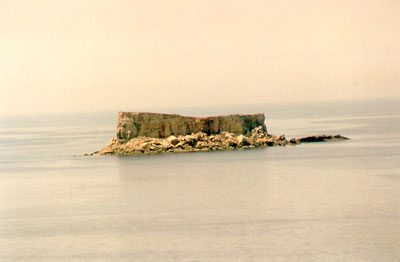
An island near the coastline of the
Hagar Qim: does it feature in the legends of an island of creation?
|


 The
sites are located in the middle of a modern town, which makes it
difficult to imagine the temples in a more original setting. But
that setting can be perceived in the southern parts of Malta.
The
sites are located in the middle of a modern town, which makes it
difficult to imagine the temples in a more original setting. But
that setting can be perceived in the southern parts of Malta.  The
temple of Ggantija contains – according to UNESCO – the largest free
standing stone in the world. In itself, this is not that impressive,
as there are larger stones elsewhere – they are just not free
standing. Nevertheless, Ggantija is yet another impressive temple.
What is very intriguing is that north of the temple itself, a stone
circle can be found – showing that “classic megalithic monuments”
were also constructed on the island. It is here that archaeologist,
in 1987, uncovered human skeletons. The Xaghra stone circle
furthermore has a subterranean complex of natural caves, which seem
to have been used as a cemetery – thus apparently identifying this
location as a Gozo counterpart of the Hypogeum on Malta’s mainland.
The
temple of Ggantija contains – according to UNESCO – the largest free
standing stone in the world. In itself, this is not that impressive,
as there are larger stones elsewhere – they are just not free
standing. Nevertheless, Ggantija is yet another impressive temple.
What is very intriguing is that north of the temple itself, a stone
circle can be found – showing that “classic megalithic monuments”
were also constructed on the island. It is here that archaeologist,
in 1987, uncovered human skeletons. The Xaghra stone circle
furthermore has a subterranean complex of natural caves, which seem
to have been used as a cemetery – thus apparently identifying this
location as a Gozo counterpart of the Hypogeum on Malta’s mainland.

 The
possibility that the religion of the Maltese temple builders was sun
worship seems likely, particularly when certain information,
identified by Joseph Ellul, is taken into account. Ellul’s father
was the caretaker of the Hagar Qim complex – a privileged position
to learn much about the complex and be confronted with a wide
variety of visitors, each giving their insights.
The
possibility that the religion of the Maltese temple builders was sun
worship seems likely, particularly when certain information,
identified by Joseph Ellul, is taken into account. Ellul’s father
was the caretaker of the Hagar Qim complex – a privileged position
to learn much about the complex and be confronted with a wide
variety of visitors, each giving their insights. 